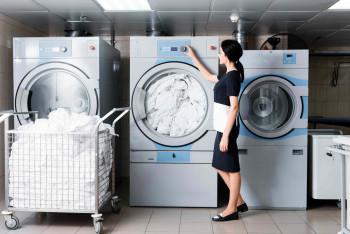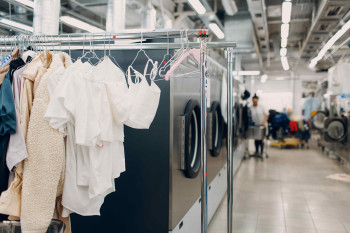"Fabric identification in laundry and dry cleaning Business
Fabric identification is the main role of the Master. To be a master in the cleaning process one must understand the fibres deeply. In today‘s world, there are so many types of fibres but basically, we can divide them into two parts
- Natural
- Man-made
These fabrics are then combined usually by a spinning process, to form yarn or continuous threads which can then, in turn, be woven or knitted into fabrics.
The various sources of fibres and methods of transforming them into fabrics are most simply illustrated in the following diagram.
Every Fibre is different from others. You must understand no matter if the cloth looks the same. Sometimes even labels don’t mention it, special local brands. It will take almost a year to learn about fabric just by touching it.
To start laundry and dry cleaning business you must have a elementry knowledge of fabrics. This is the most crucial part of sorting the garments according to the loads
Fabric Identification:
While one hundred percent reliable fabric identification can be carried out in the laboratory using established microscopic and chemical analysis techniques, these facilities are unlikely to be available to the dry-cleaner and more rapid and practical methods are required.
Simple, practical but time-proven tests include:
- Visual inspection:
Natural vegetable fibres like cotton and linen can be readily recognized by the naked eye. Threads are comparatively limp and, when pulled apart until they snap, the ends of the fibres appear fine, light and fluffy like cotton wool or the seed heads from which they came.
Woollen yarn by contrast is springy and a simple magnifying glass will help identify the characteristic scales on the surface of the individual fibres.
Nylon fibres appear like a smooth, continuous fishing line under the magnifying glass. Acetate rayon is similar but less smooth and viscose-rayon fibres have flecked lines along their length.
Silk can be identified with an eye-glass by its almost triangular cross-section but it is easier to distinguish from rayon using the burn test (see below). Polyester is also best distinguished from nylon, which it resembles visually, using the burn test.
Tear test:
A piece of cotton or linen cloth or yarn becomes noticeably more difficult to tear when it is wet while the opposite is true with viscose rayon fabric.
A tear test can be carried out with a length of yarn to distinguish between cotton and wool. If well wetted in the centre, a cotton yarn will break most easily where it is wet and wool where it is dry.
Linen can be distinguished from cotton by moistening a small area with sewing machine oil. Linen becomes translucent but cotton does not.
Solubility test:
Sample yarns can be immersed in test tubes of differing solvents in the sequence shown below and then examined first after five minutes at room temperature and then after boiling for a few minutes.
It is a useful exercise to take a few garments from “uncollected” stock and practice the above test a number of times to develop fibre recognition skills.
Float test:
This is a quick and simple test for the presence of polypropylene fibres which are often included in cheaper garments labelled “mixed fibres”. These fabrics typically shrink by 15-20% and are better washed gently using SEITZ Wet set chemicals than dry-cleaned.
Tease out some fibres from a hidden hem, separate them into individual fibers and sprinkle into a glass of cold water. Fibers that float are likely to be polypropylene (because it does not absorb water).
Burn test:
Careful observation of a length of yarn, when exposed to a naked flame, can identify the fiber with some degree of certainty. Take a sample of thread from a hidden seam (do not expose the garment itself to the flame!) and bring it towards the flame rather than the other way round. Notice whether it melts or burns, the speed of combustion, the color of the flame and the type of smoke given off. If it appears that the fabric contains more than one kind of thread (e.g. the warp may be different from the weft) don’t forget to test both.
Let look in detail for the fiber you encountered in Laundry
Fiber Characteristics
Cotton and polyester are the two main fiber types you will encounter while washing linen from healthcare, restaurants and lodging accounts.
Fibers are classified by their origin, and are either “natural” or “man‐made.” Natural fibers are composed of plant (cellulose), animal (protein or silk) or synthetic (Polyester) materials. Cotton is a natural, cellulose fiber, while polyester is man‐made.
Cotton
Cotton fibers are used to produce fabrics that are characterized by good wearing qualities, excellent “launder ability” and high absorbency. Comfort is the outstanding characteristic of fabrics made from cotton. This is because cotton is water loving (hydrophilic) and easily absorbs water (as much as two to three times its own weight). This property allows the fabric to “breathe,” making it very comfortable to wear.
Care of cotton is demanding. Detergents have no negative effect on the fiber. Alkalis can have a huge negative effect on the fiber if overused. In fact, the mercerization process (a process often used during manufacturing of cotton textiles) uses caustic soda to treat cotton so it becomes stronger (increases tensile strength) and more lustrous than ordinary cotton.
Cotton does have some disadvantages though. Untreated cotton lacks elasticity. It creases and wrinkles easily. It can be attacked by mildew. Exposure to strong acids and lye can cause fabric damage. To overcome some of these disadvantages, special finishes (permanent press or wash and wear) can be applied to the fabric during manufacturing.
While cotton can be bleached safely with chlorine bleach, improper or overuse of this laundry chemical can cause fabric degradation (either localized damages or overall loss of tensile strength).
Chlorine bleach is the single most misused product found in the laundry. Some of the finishes used to treat cottons are chlorine retentive (will not allow the chlorine to rinse out of the fabric) and necessitate special handling. This subject is covered thoroughly in the section on the wash formula.
Polyester
Polyester fiber is used in a variety of items because it has excellent resilience and recovery from creasing and wrinkling. It is very resistant to attack by acids and bleaches (accept chlorine bleach) and exhibits good resistance to weak alkalis. It is not attacked by insects but can be attacked mildew. The most important characteristic of polyester fibers are their strength.
Polyester is a water hating (hydrophobic), oil‐loving (oleophilic) fiber. This means it has very low water absorbency and a natural affinity for oily soils. This affinity for oil‐based soils makes it more difficult to clean than cotton.
Care must be taken when washing polyester or polyester blended items to use the right laundry chemicals and washing conditions to avoid greying of whites that can occur.
Because it does not absorb water like cotton, polyester does not require as long extraction time, or lengthy drying times.
Over extraction, thermal shock (wrinkling of the fabric caused by too rapid cooling during washing or finishing), and over drying can cause permanent wrinkling to the fabric. To overcome these concerns, polyester is frequently combined with cotton.
If polyester or polyester cotton garments are need to be washed at higher than 60 C temperature, a cool‐down step has to be applied in the wash process to overcome excessive creasing or wrinkling. Most modern washer extractors have cool‐down steps pre‐programmed
Knowing the main differences between polyester and cotton helps you understand why they should be separated from one another before they are laundered since they require different cleaning and finishing methods.
Polyester/cotton blends
Many items encountered in OPLs are made from a blend of polyester and cotton fibers. Each fiber, polyester and cotton, has its own advantages and disadvantages. By blending the fibers, the best qualities of each fiber
can be combined to improve comfort, durability and cost. The reason for using a specific blend will depends on the purpose and care of the article.
Fabric Construction
A laundry account representative should be able to identify the variety of materials that must be sorted before they are laundered. This section will review construction and how this effects linen classification or sorting. For the small OPL, fabric construction differences that play an important role in sorting can be divided into three basic categories or classifications: flatwork, terry towels and incontinent goods.
Flatwork
Flatwork consists of sheets, pillowcases, tablecloths and napkins. Although some 100% polyester table linen is available, the majority of the linen found in this category consists of cotton or polyester/cotton blends. Sheets are produced in 50/50 and 65/35 blends along with 100% cotton. (In fabric blends, the polyester percent is listed first, followed by the cotton.)
Normally the linen in this category is finished on a flatwork ironer, which is one reason why it should be separated from other linen of similar weight and fiber content. In very small OPLs a flatwork ironer may not be available. In this case, the flatwork will be tumbled dry and folded.
Flatwork is not as absorbent or as heavy as other linen classifications, such as terry or incontinent goods, and requires shorter extraction times.
Terry
Terry goods such as towels, washcloths, bathmats or bathrobes can be heavy and dense (bulky) and, because of their absorbency, require longer extraction times than other linen classifications.
Good neutralization is particularly important if chlorine bleach is used on the white goods. If the chlorine is not neutralized in the fabric, it can carry over into the sour operation, react with the acids used in this operation and cause degradation of the cotton fibers. Residual chlorine can also cause damage to cotton when the fabric encounters the high temperatures of the dryers or ironers.
In case bleaching with chlorine is required, it is advised to neutralize the chlorine at the end of this bleaching step or together with the following wash step by using an oxygen bleach.
Incontinent goods
Making fibers into yarns and then weaving them into a fabric is just one way of constructing items. Constructing the item in layers of different materials to obtain the desired characteristics is another method of construction. Adult diapers and incontinent pads are examples of combination fabric construction.
Adult diapers are designed for wear by incontinent patients to absorb and retain fluids while keeping the patient comfortable.
Incontinent pads are very similar to adult diapers. They are placed under incontinent patients to provide comfort and to protect the bedding.
Incontinent goods usually are constructed from three layers. The outer layer is a waterproof barrier made from either rubber or vinyl. The top or inner layer (that closest to the patient) may be 100% cotton birds‐eye fabric or various blends of fibers woven into a fabric.
Between the inner and outer layer is an absorbent layer, usually a synthetic material of a non-woven design with capillaries designed to wick fluids away from the top layer.
Like terry goods, incontinent items are bulky, absorbent items which, in addition the rubber barrier, makes them even more difficult to thoroughly rinse and extract.
In many instances you cannot use a fabric softener if this is a silicone based softener as it plugs the capillaries on the absorbent layer and impairs its absorbency. The rubber barrier also is heat sensitive and should not be dried at high temperatures
Fabric finishes
There are two classes of textile or fabric finishes: temporary and permanent. Examples of temporary finishes are fabric softeners, mildewcides and starch. They are added during the last operation of the wash formula. Permanent press, along with Visa (a soil-release finish used on 100% polyester fabric), are examples of permanent textile finishes applied during manufacturing.
In many aspects, permanent press finishes have been a blessing for the laundry industry, but some have been a headache due to bouts of chlorine retention and “fishy odours.” Chlorine retention can cause several problems. In extreme cases, it can create a permanent yellowing of the fabric (damaged optical brightener), damage the cotton fibres and cause skin irritation. The only means of solving the problem is to use oxygen bleach to neutralize residual chlorine completely at the end or after each bleach operation.
If the laundry is aware of the chlorine retentive finish, or the goods have care labels which advice against the use of chlorine, the problems can be avoided by pre‐sorting chlorine retentive goods from the rest of the linen so that chlorine bleach is not used on them.
In general chlorine bleach is only recommended if there is no other way (by using oxygen bleach) to achieve good results on bleachable stain removal.
"











